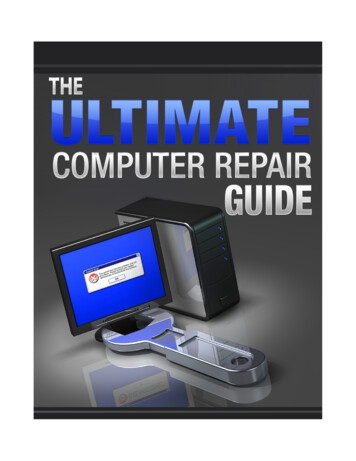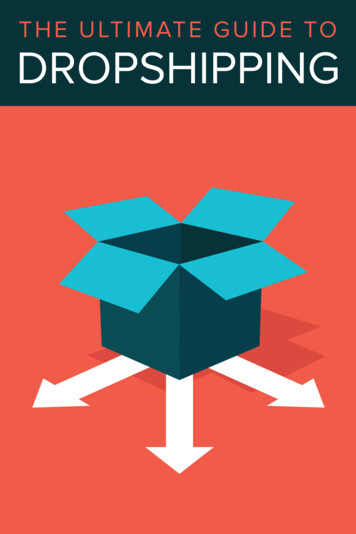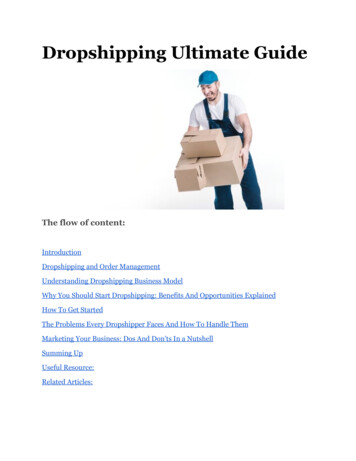
Transcription
the ultimateguide to creditmanagementsoftwareOnGuardsoftware for credit management
the ultimate guide to creditmanagement softwareMore and more companies have adopted new technologies that enable themto achieve more without sacrificing the personal touch that ensures customersatisfaction. As a result, credit management software is swiftly becoming thenorm in some organisations as they seek to automate basic processes, lightenthe administrative burden on employees and continue offering the bestpossible service.so what is credit management software, and how does it work?This guide tells you everything you need to know about credit managementsoftware - what it does, how it works and how businesses can get maximumvalue from it. After reading this you will be ready and equipped to startimproving your credit management function with the highest qualitytechnology.how to use this guideThis guide is a self-paced reference guide. It will allow you to learn aboutcredit management software in your own time and can be used for referencewhen appropriate. With the right information at your fingertips, you will beable to make informed decisions about credit management software that willlead to the best outcomes for your organisation.what you will learnReading this guide will leave you with a better understanding of creditmanagement software and how it could benefit your organisation.You will learn about what it is and why organisations are using it more oftento improve efficiency and boost their performance. In addition, you’ll find outwhat to look for in credit management software and some of the advancedfeatures it can provide. What’s more, you will even learn about puttingtogether the business case and promoting credit management softwareinternally.2
contentspart one: definitions and ideas. 04what is credit management software?. 04what is it for?. 04what does it do?. 05who does it suit?. 05part two: rising demand. 06drivers of demand. 06will it work with my Enterprise Resource Planning (ERP) system?. 07benefits of credit management software. 07part three: where to start - a buyer’s guide. 10common features of credit management software. 10additional features. 10tailor to your needs. 11part four: getting the best from credit management software. 12integrating with third-party systems. 12closer to the customer. 12use across the organisation. 13part five: building a business case. 14what is a business case?. 14what needs to be included?. 14projected costs and initial investment. 14key benefits of the project. 15ROI. 18does it meet business objectives?. 18time to value. 18time to payback. 18part six: promoting change. 19understanding your audience. 19conducting the conversation. 20discuss, don’t present. 20know your numbers. 20making the best choice. 213
part one: definitions and ideasThis chapter looks at what credit managementsoftware does and who is using it.what is credit management software?Credit management software is a category of software that prioritisesand streamlines credit management workflows, as well as storing keyinformation and preparing or performing many of the day-to-day taskscarried out by the credit management team.Credit management software can be integrated into the wholeorganisation, and (part of) its other software systems.what is it for?It’s used to improve the efficiency of the credit management function, freeingup employees’ time to focus on the high priority and more complex tasks.Organisations also adopt credit management software so they can offer customersa better experience, thus improving customer relationships and ensuring repeatbusiness.Not all software packages are created equal when it comes to these functions.Some will also integrate accounts receivables across the whole organisation sothat every function can access payment data when they need to. Some softwaresolutions offer role based functionality and subsequent possibilities to shareinformation with specific roles within the organisation. That gives everyone in theorganisation a fuller view of each customer’s experience so far.4
part one: definitions and ideaswhat does it do?Credit management software can cover a huge variety of credit managementdunning reporting creatingworkflows and daily task listscustomersegmentation credit management softwarefunctions, including: scoring interest andcost calculationscomplaints management cash allocationWhatever task it’s performing at any stage of the payment cycle, the point of thesoftware is to put the maximum amount of information at the fingertips of thecredit management team. By automating many of these everyday functions, creditmanagement software frees up the time of staff within the department so they candevote their time to priority issues.who does it suit?Large organisations can benefit from credit management software, but the sameis also true for smaller businesses - especially if their workload is rising faster thanthe current credit management team can manage. For some companies, the costof investing in the software could be a substantial saving compared to the price ofexpanding their headcounts.Equally, business-to-business sectors may often make the greatest use of creditmanagement software, largely because trade credit is so common in areasfrom manufacturing to professional services. However, even in consumer-facingenvironments the same software can be a valuable tool.5
part two: rising demandIn this chapter, we’ll look at how and why demand forcredit management software is mounting and how it canbenefit organisations.drivers of demandeconomic recovery. Existing businesses are benefiting from economic recoveryin key global markets, while more and more new companies are springing upworldwide. An improving economic outlook means that businesses are growingagain after the global financial crisis, and their operations and customerrelationships are becoming more complex as a result. And in some cases, continueduncertainty has led to a focus on liquidity that has made credit more significant.international trade. What’s more, international trade is increasingly the norm fororganisations. As working across borders becomes more common, further layers ofcomplexity are being added to the mix. Differing regulations and business etiquetteas well as simple barriers such as language and currency are increasing the time andoperating costs associated with trade, as well as filling firms’ order books.greater levels of competition. Of course, growing and increasingly globalisedmarkets are also promoting greater levels of competition between organisations.That does mean that they are seeking to keep costs down by becoming as efficientas possible, but it has placed an even greater emphasis on the quality of customerservice. What’s more, since some verticals are already operating on thin marginsthat are increasingly under pressure, every paid invoice counts.focus on customer relationships. Customers are far more likely to proceed theirrelationships with organisations if service is satisfactory. Research from Accenturefound that two out of three customers surveyed had switched providers in at leastone of a selection of industries in the prior 12 months as a result of poor service1.financial motivation. Once a customer has been driven away by bad service, it’salso very difficult to repair the damage without financial cost. It’s more expensiveto bring a new customer on board than it is to retain an existing one. In fact, aForrester report showed that better customer experiences lead to much healthierrevenues for the US companies surveyed. In one industry alone, wireless serviceproviders, customer loyalty had an annual impact of 3.1 billion in terms of word ofmouth, churn reduction and further purchases2.12Accenture, Maximising Customer Retention: A strategic approach to effective churn management, 2011.Forrester, The Business Impact of Customer Experience, 2013.6
part two: rising demandwill it work with my Enterprise Resource Planning (ERP) system?Ultimately, ERP and credit management software are different systems seekingto achieve very different goals. ERP tracks the movement and distribution ofresources within a complete organisation. On the other hand, credit managementsoftware tracks invoices and customer behaviour to meet the needs of a specificfunction - although by integrating accounts receivables, it can also have widerbenefits for the organisation as a whole. The important thing to remember is thatERP and credit management software aren’t in competition- in fact, they can beused in harmony with each other.3 benefits of credit management softwareCredit management software offers businesses of every size and specialism anumber of significant benefits. Based on our experience, we have identified thesetop benefits:1) efficiencyHuge amounts of time and resources are easily wastedinputting data, reconciling invoices and a number ofother everyday tasks. By automating these simple andstraightforward processes, you can substantially improvethe efficiency of your credit management function, freeingup their time to focus on business critical and priority tasksthat have the highest return.‘Credit controllers can be assigned to a specific area of yourbusiness; you can put multiple contacts on there and run acomplete automatic dunning process. So there is no enveloplicking or time consuming tasks, overall it’s very cost effective.’Tony McCormick, credit manager, ALcontrol7
part two: rising demand2) betterThe ultimate aim of credit management software is to helpcash flowbusinesses get paid faster. By freeing up time to be spentmanagementcommunicating with customers as well as other tasks, andeven giving the customer more control to manage theirown payments, organisations can increase the chances thatthey will receive full payment by the due date. In turn, thatwill improve liquidity and empower firms to manage theircash flow better.Atradius found in its latest Payment Practices Barometerfor Western Europe that 37.6 per cent of the total value ofB2B invoices in the region were eventually paid after thedue date. A proportion of this was never claimed at all:businesses in the region eventually lost around 35 per centof all receivables that are not paid within 90 days3.That is likely to lead to tough cash flow issues in at leastsome of the businesses surveyed. Any measures that acompany can take to reduce the financial loss incurredthrough non-payment are surely worthwhile.‘The speed of payment is an indication of the relationship withthe customer and the quality of service in my opinion. If therelationship and service are good, customers are satisfied andhappy to pay for it more quickly.’Alfred Strop, manager, treasury, cash managementand credit control Benelux & The Nordics, Atos3Atradius, Payment Practices Barometer Western Europe, May 2014.8
part two: rising demand3) maximumTo ensure they are offering the best possible products andinsightservice, organisations need the fullest possible insightinto the behaviour of their customers. For that purposethey need to be able to capture and then interpret largeamounts of data. Credit management software allows forcomprehensive data capture - combined with advancedanalytics, this can offer the whole organisation valuableinformation to inform future practice.Not only can this customer insight feed back intosales and marketing efforts (for both new and existingcustomers), but it will also shed light on the organisation’sown operations. Analysis will highlight the areas whereprocesses need to be improved to boost underlyingperformance. Of course, improved reporting will beanother product of the software, opening up better ways todemonstrate value for stakeholders.9
part three: where to start- a buyer’s guideThis chapter will investigate the common featuresof credit management software and what to lookfor in a solution.common features of credit management softwareThere are some basic functions that every credit management softwarepackage should be able to cover, which will free up time and enablecredit managers to be more efficient and productive while reducing theorganisation’s operating costs.a) credit- Segmentation according to set criteria and key triggers.- Scoring on customer behaviour and attributes.- Basic credit reporting functions.b) collections- Sending out reminders by email or post (dunning).- Immediate knowledge of late or non-payment to sendfurther reminders.- Creation of day-to-day to-do lists from current workflow.c) complaints- Registration according to your own explanations, codes andpossible actions.- Delegation of relevant tasks and investigations to other teams.- Monitor progress of complaints and inform of resolution.additional featuresThere’s a long list of the basic functions that any software package does, but thereare some very significant advantages to these extra functions that can make abig difference to the performance of the credit management function and widerorganisation.10
part three: where to start- a buyer’s guideadditional featuresCash allocationlinking bank statements to invoices to keep track ofwhich payments have been successfully received.Integration withthird partiesworking in harmony with other systems such as ordermanagement or ERP software to provide maximumvalue for the whole business.Building customerprofilesprofiling customers will help to inform dunningpolicies for different segments of the customer base.Advanced analyticsand reporting capacityhigher-level analytics and reporting will improveorganisations’ visibility over their operations as wellas their customers.Customer portaloffering customers their own point of access toyour credit management software allows for anumber of self-service functions which reducethe administrative load on organisations whileempowering cuss with a sense of ownership overtheir own information and funds.tailor to your needsEvery organisation is unique, and even their most basic needs may well differsignificantly. The real best-in-class credit management software options can betailored to your individual needs, making it easier for employees to use the systemto its full potential and begin to see the benefits much more quickly.11
part four: make the most fromcredit management softwareThis chapter will look at how organisations canmake the most of credit management software toadd value.integrating with third-party systemsCredit management should not exist in a vacuum. It should workalongside other functions within the organisation to ensure thatcustomers get the best possible experience - after all, a customer candeal with sales and marketing, customer services and complaints as wellas the credit management team. So it makes sense that the softwareused in different areas of the business should co-operate as well.By integrating credit management software with other systems, organisationscan eliminate the need for data duplication between systems, or the hassle ofimporting and exporting data. Of course, the fact that information can be sharedautomatically also means that everyone has access to the most recent data,keeping the whole organisation up to date and fully aware of each customer’sneeds. Because they all have that complete view of the customer experience, theycan use it to make sure that every communication between customer and companyis positive.closer to the customerThe greater the customer’s involvement with the credit management side of therelationship, the better. Every customer should have the freedom to view theinformation you store regarding them and update or correct it where necessary.Registering their own invoices will also contribute a feeling of control for yourcustomers. The chances are that will also help to reduce the number of disputesyou deal with, since the customer has the opportunity to follow the creditmanagement process at every stage.Giving them a level of ownership over their own information transforms them froma customer into a partner and totally changes the dynamic of every interaction. Itcould well be a significant factor in boosting your customer satisfaction ratings andencouraging repeat business.12
part four: getting the best fromcredit management softwareuse across the organisationDon’t just stop at linking credit management software to the systems usedelsewhere. Integrating accounts receivables across the whole organisation givesevery function access to relevant, current customer information as and when theyneed it. In turn, that helps to develop a customer-focused culture in anyone cangain a 360-degree view of each customer.For example, sales teams should know about customer behaviour to ensure theyare targeting the right prospects, as well as taking the right steps to reach themeffectively. By the same token, collections teams need to know about ongoingcomplaints, as this affects whether they should contact customers about nonpayment. Wherever the information comes from, putting it all in one place allowsfor greater empathy from employees - which will prompt better service. Thatbrings in repeat business.13
part five: bui
businesses get paid faster. By freeing up time to be spent communicating with customers as well as other tasks, and even giving the customer more control to manage their own payments, organisations can increase the chances that they will receive full payment by the due date. In turn, that











